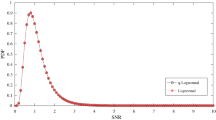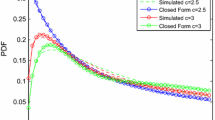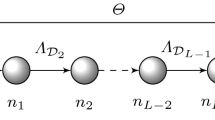Abstract
Physical fading radio channels encountered in wireless mobile communication are often modeled as a complex Gaussian process whose envelope is statistically described by Rayleigh or Rician probability distribution function (PDF). In most of the literature, the accuracy of the simulation model is estimated by comparing the simulated autocorrelation function (ACF) of inphase (or quadrature phase) component of the fading process and ACF of squared envelope with the analytical ones. In this paper, we examine the performance of a sum of sinusoid (SOS) based Rician fading channel simulator on the basis of the ACF and power spectral density (PSD) of the fading envelope. We obtained simplified approximate expressions for the autocorrelation and mean value of the fading envelope which become more accurate as the value of Rice factor increases. In the simulation, the line-of-sight (LOS) component is modeled as a zero-mean random variable with pre-chosen angle of arrival (AOA) and random initial phase. We showed that the AOA of the LOS component significantly affects the level crossing rate (LCR) and average fade duration (AFD) of the fading envelope. All simulation results are compared with the analytical results and a very good agreement between them is found.
Similar content being viewed by others
References
Clarke R.H. (1968). A statistical theory of mobile-radio reception. Bell System Technical Journal 47(6): 957–1000
Yip K.-W., Ng T.-S. (1996). Discrete time model for digital communications over a frequency selective Rician fading WSSUS channel. IEE Proceedings Communication 143: 37–42
Patzold M., Killat U., Laue F., Li Y. (1998). On the statistical properties of deterministic simulation model for mobile fading channels. IEEE Transactions on Vehicular Technology 47: 254–269
Xiao, C., & Zheng, Y. R. (2003). A statistical simulation model for mobile radio fading channels. IEEE Proc. WCNC’ 2003, Vol. 1, pp. 144–149 March 2003.
Wilson, S. K., Khayata, R. E., & Cioffi, J. M. (1994). 16 QAM modulation with orthogonal frequency division multiplexing in a Rayleigh fading environment. In Proc. VTC’1994, Stockholm, Sweden, pp. 1660–1664, June 1994.
Yang B., Lataief K.B., Cheng R.S., Cao Z. (2001). Channel estimation for OFDM transmission in multipath fading channels based on parametric channel modeling. IEEE Transactions on Communications 49: 467–479
Hanzo, L., Munster, H., Choi, B. J., Keller, T. (2003). OFDM and MC-CDMA for broadband multiuser communications, WLAN and broadcasting. Wiley.
Mohanty, S., & Akyildiz, I. F. (2004). An accurate velocity estimation algorithm for resource management in next generation wireless systems. In Proc Decision and Control, 2004. CDC. 43rd IEEE Conference, Vol. 3, pp. 2848–2853.
Zheng Y.R., Xiao C. (2002). Improved models for the generation of multiple uncorrelated Rayleigh fading waveforms. IEEE Communication Letter 6: 256–258
Stüber G.L. (1996). Principles of mobile communication. Boston, MA: Kluwer
Kreyszic, E. (2001). Advanced engineering mathematics (8th ed.). Wiley Publication.
Proakis, J. C. (2001). Digital communication. (4th ed.). McGraw Hill.
Tranter W. H., Shanmugan K. S., Rappaport T. S. and Kosbar K. L. (2004). Principles of communication systems simulation with wireless applications. Pearson Education
Author information
Authors and Affiliations
Corresponding author
Rights and permissions
About this article
Cite this article
Trivedi, A., Gupta, R. On the Analysis of Envelope Correlation and Spectra for Rician Fading Channel. Wireless Pers Commun 47, 281–292 (2008). https://doi.org/10.1007/s11277-008-9461-x
Received:
Accepted:
Published:
Issue Date:
DOI: https://doi.org/10.1007/s11277-008-9461-x




